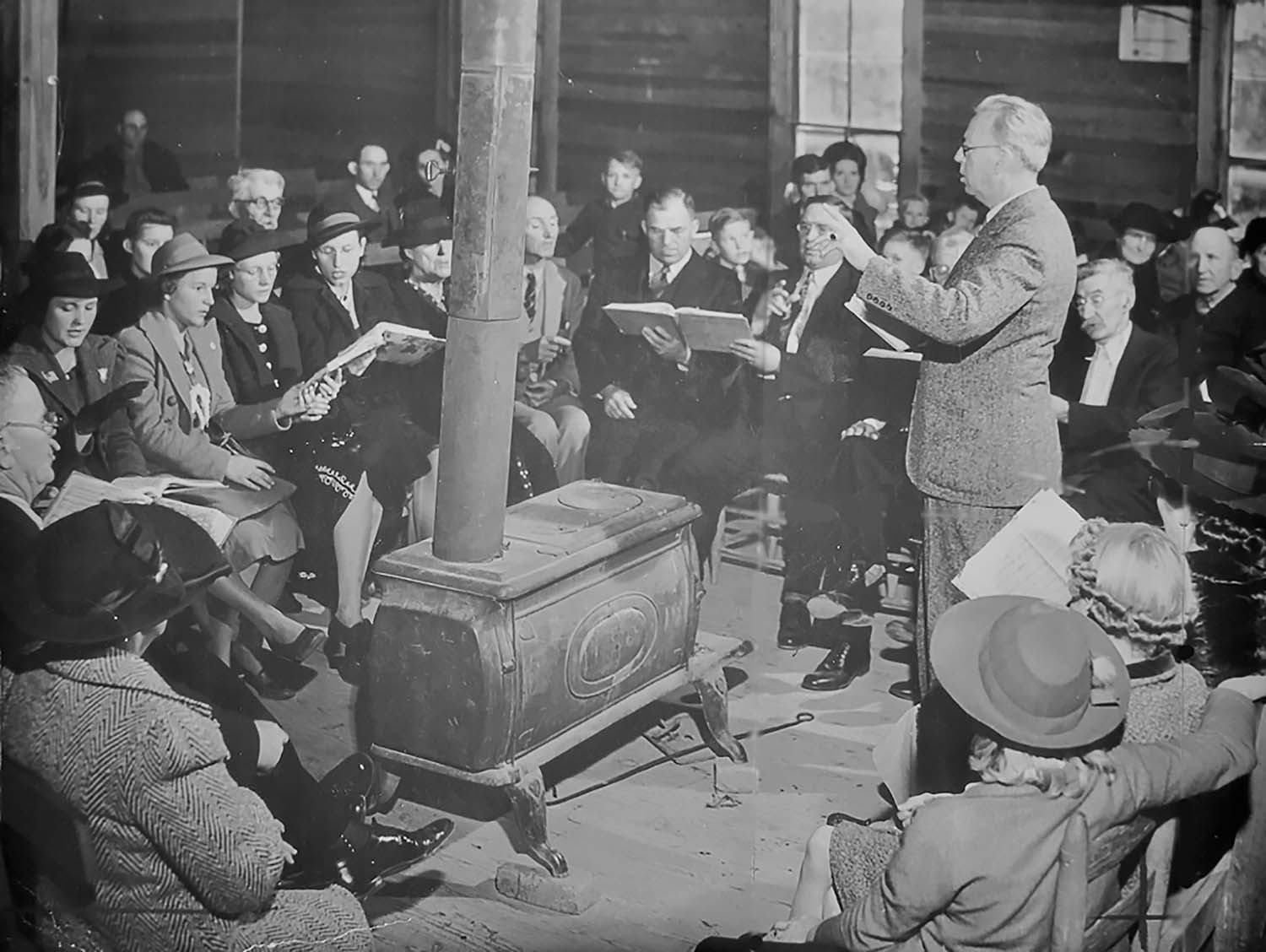
Renowned musicologist George Pullen Jackson, a pioneer in Southern hymnody, leads singers circa 1941. Photo used courtesy of Zack Allen Heritage Books.
It’s 1906, and the air inside Etowah Methodist Church probably smells of a recent church supper: cornbread and pickled okra. Families are settled in hard pews, their shoulders swaying slow to “Amazing Grace” and lesser-known hymns like “Hosanna” and “How Firm a Foundation.” Soon a dairy farmer will rise, maybe remind the congregation it’s milking time. And this will bring the shape-note-singing session to a close.
After more than a century — a century and a decade, to be exact — not much has changed. Though hosted at the Etowah Lions Club, the biannual Etowah Christian Harmony shape-note singings retain a timeworn spirit. “It feels like you’re walking into the 1850s,” says member Scott Swanton.
As an eighth-generation Henderson County native, Swanton learned the tradition of shape-note singing from his great-grandfather, a man he called Papaw. What Papaw taught was simple: memorize seven geometric shapes and their respective sounds. A trapezoid for “do,” a crescent moon for “re,” and so on. After getting a feel for the tune, add in song lyrics.
The method was nothing new for mountain folk. In the early 1800s, the practice emerged as an accessible way to sight-read unaccompanied fiddle tunes, ballads, and hymns. “Church music had degraded to a dreadful point because no one could read music and they just improvised,” explains Swanton. To increase musical literacy, American colonists began selling hymnbooks like The Easy Instructor and The Musical Primer. In 1835, South Carolinian William Walker published Southern Harmony, signaling that the custom had seeped into Appalachian culture.
“[Singing] masters would ride out on horseback to rural, isolated areas,” says Diane Eskenasy, president of Etowah Christian Harmony. These teachers held two-week sessions for a nominal fee, only requiring that students bring a candle. Papaw’s daddy, William Hyde Ledbetter, attended one such school at Cathey’s Creek Church in 1875. “People could only travel as far as they could walk,” says Eskenasy. “So shape-note singing became a reunion of sorts.”
With some northerners dismissing the practice as “uncivilized” and “brutish,” it also became a largely Southern tradition. Today, shape-note singings are hosted all around Western North Carolina. Each July, Warren Wilson College houses the Swannanoa Gathering, a traditional-music conference that includes the practice, and in late September, Western Carolina University puts on Mountain Heritage Day, also a shape-note-singing venue. Still, despite the local organization’s landmark year, Swanton fears the custom is fading with passing generations.
“Isolation played a big role in preserving it for this long,” he says. “Until the railroad came through, nothing changed because mountain people tend to be conservative. Now we’re struggling to keep this musical tradition alive.” But it’s worth noting that “Old Folks Day,” a September sing at Morning Star Methodist Church in Canton, has been going on even longer than Etowah’s event — 127 years. And then there’s the new shape-note singing school held in the historic Shook-Smathers house in nearby Clyde. Named after traveling singing master Quay Smathers and started by his children, the daylong annual workshop turned two in April.
“Community shape-note singings used to be the only game in town besides church,” explains Eskenasy — and are certainly no match for today’s endlessly accessible entertainment. However, she adds, “these 110 years of singing in Henderson County are too important to our cultural history — we can’t let it die out.”
Etowah Christian Harmony will host the fall installment of its 110th annual singing event on Saturday, September 2, 10am-3pm at the Etowah Lions Club (447 Etowah School Road). Free. No experience is required. Singing books will be available for loan or purchase. For more information, visit etowahshapenote.org or contact Diane Eskenasy at dogsongs@gmail.com.
